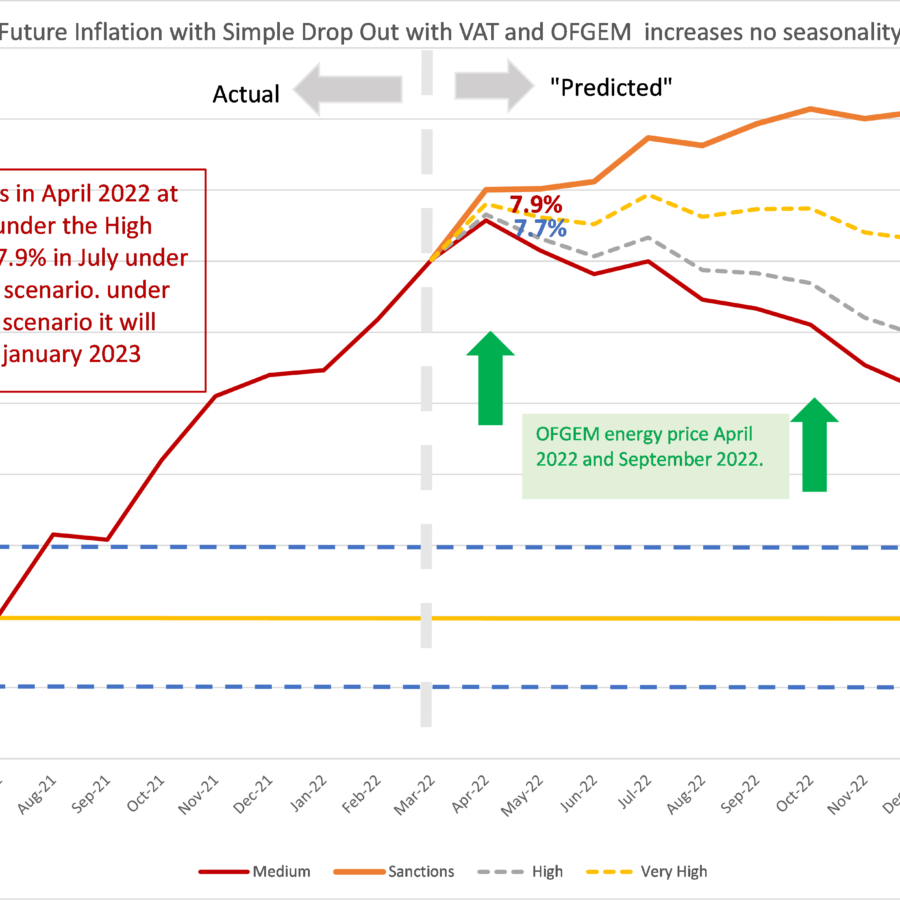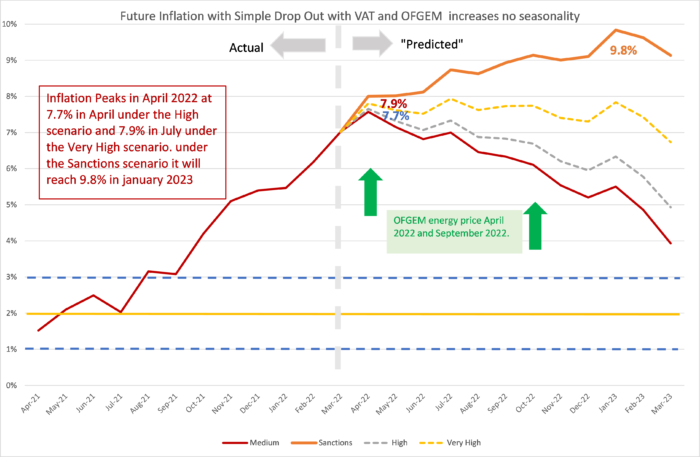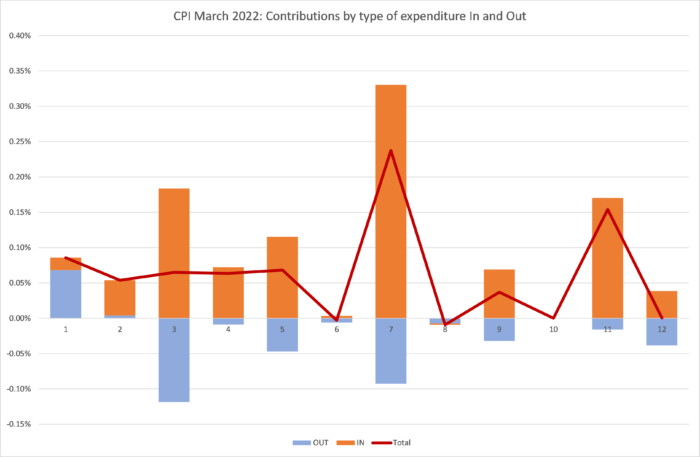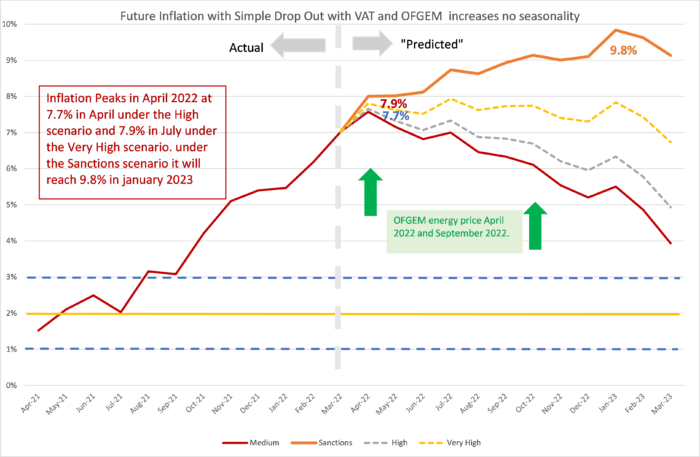Surging Inflation Shows No Signs of Slowing

CPI rose to 7% in March from 6.2% in February. Month on month inflation between March and February was very high at 1.1% – if this was sustained for 12 months, there would be 14% inflation by February 2023.
The surge in inflation was across most types of consumer expenditure. The main contributors to the surge in inflation were:
- Transport (0.24%)
- Restaurants and Hotels (0.15%)
- Food and Non-Alcoholic Beverages (0.09%)
The surge in prices in March followed on from a large increase in February, showing that inflation is becoming entrenched. Food in particular has been rising rapidly since September 2021. Prior to the outbreak of war in Ukraine, we expected inflation to peak in April 2022 with the OFGEM price cap being raised. The March inflation figures are based on prices in early March, so that the impact of the start of the war will not have had time to have much impact.
The future path of inflation depends crucially on how the war itself affects the world economy and more importantly the impact of sanctions imposed on Russia by the Western powers. The war and sanctions will have major effects on certain commodities, including:
- Wheat and other grains: Russia and the Ukraine are major exporters of Wheat and prices started to increase even before hostilities started. The supply of agricultural goods from Ukraine is directly affected by the war, as is the export of Russian produce via Ukrainian ports.
- Fertilizer: the price has already spiked in anticipation of future shortages. Belarus/Russia and Ukraine produce a large amount of it. Russia is 20% of world supplies plus ingredients to make it elsewhere (urea, ammonia, and potash). This will increase the cost of food across the globe.
- Neon: About 50% of the world’s semiconductor-grade neon, critical for the lasers used to make microchips, smart phones etc, comes from two Ukrainian companies, Ingas and Cryoin. Ingas is based in Mariupol and Cryonin in Odessa. World stocks will run out in April.
- Metals: Russia is a significant producer of gold, nickell, palladium, copper and aluminium.
- Energy: Russia is a major supplier of oil, coal and natural gas.
How the war and sanctions play out will determine exactly what happens in each case. However, it is certain that all of these commodities will be affected to some extent and that restrictions on supplies will be a major driver of inflation in the UK and around the world. Currently, sanctions have been imposed by what are often called the “Western powers”, the US, Canada, Western Europe and their close allies in the far East (Japan, South Korea and Singapore and Taiwan). The impact of sanctions on the UK economy will also depend on whether secondary sanctions are imposed on other countries that trade with Russia and how effective these secondary sanctions are. The more effective the sanctions are, the greater the future effect on inflation.
Russia has also linked the payment for energy by Europe and others to the Rouble and pegged the Rouble to gold. Whilst the current prices paid in Europe are set in Euros, in the longer run Russian energy prices may be set in Roubles and this may lead to an appreciation of the Rouble and hence in increase in the UK (Sterling) price of energy.
Turning back to the March inflation figures, we can look in more detail at the contributions of the different sectors to overall inflation, we can look at the old inflation dropping out of the annual figure (February-March 2021) and the new monthly inflation dropping in (February-March 2022) and use the expenditure weights to calculate CPI. In the chart below, we show the “dropping out” in blue and the “dropping in” in light brown. The overall effect is the sum of the two and is shown as the burgundy line.
By far the biggest contributor to inflation was Transport, with an overall contribution of 0.24% resulting from a very large drop in on 0.33% partly offset by a drop out of 0.1%. Restaurants and Hotels contributed 0.15% of which 0.17% dropped in and -0.02% dropped out. Six sectors had a contribution of between 0.05 and 0.1%: Food and Non-alcoholic Beverages, Alcohol and Tobacco, Clothing and Footwear, Housing Water and Energy, Furniture and Household Equipment, and Recreation and Culture. With the exception of Food and Non-alcoholic Beverages, the main effect came from new inflation dropping in. The remaining sectors (Communications, Miscellaneous Goods and Services, Education and Health) contributed little to overall inflation.
Extreme Items
Out of over 700 types of goods and services sampled by the ONS, there is a great diversity in how their prices behave. Each month some go up, and some go down. Looking at the extremes, for this month, the top ten items with the highest monthly inflation are:
| Table 1: Top ten items for month-on-month inflation (%), March 2022 | |
| Men’s Branded Sport Sweatshirt | 71.60 |
| Kerosene – 1000l Delivered | 45.16 |
| Smart Speaker | 25.73 |
| Boys T-Shirt 3-13 Years | 21.37 |
| Internet Computer Games | 20.61 |
| CD’s- Purch Over Internet | 16.30 |
| Margarine/Low Fat Spread-500g | 15.19 |
| Womens Short Sleeve Formal Top | 14.55 |
| Mens Branded T-Shirt | 13.20 |
| CD Album (Not Chart) | 12.88 |
The ten items with the highest negative inflation this month are shown in Table 2.
| Table 2: Bottom ten items for mom inflation (%), March 2022 | |
| Whole Sponge Cake Not Frozen | -8.29 |
| Cook-In Sauce-Jar/Can 350-520g | -8.53 |
| Froz Chicken Nuggets 220-600g | -8.92 |
| Shower Gel 150-250ml | -9.45 |
| Premium Potato Crisps/Chips | -10.41 |
| Dishwasher Tablets Pack 16-45 | -11.29 |
| Strawberries Per Kg Or Punnet | -11.80 |
| Music Downloads | -14.04 |
| Action Camera | -15.36 |
| Ebooks | -22.53 |
In both these tables we look at how much the item price-index for this month has increased since the previous month, expressed as a percentage. These calculations were made by my PhD student at Cardiff University, Yang Li.
Looking Ahead: Ukraine and beyond
We can look ahead over the next 12 months to see how inflation might evolve as the recent inflation “drops out” as we move forward month by month. Each month, the new inflation enters into the annual figure and the old inflation from the same month in the previous year “drops out”.[1] However, the recent invasion of the Ukraine by Russia and the western sanctions in response makes things even more uncertain. That said, the invasion and sanctions are certainly going to start increasing inflation as we go forward. We have therefore adjusted our scenarios.
We do this under four scenarios:
- The “medium” scenario assumes that the new inflation each month is equivalent to what would give us 2% per annum – 0.17% per calendar month (pcm) – which is both the Bank of England’s target and the long-run average for the last 25 years. This is a reference point only, as inflation will be well above this level for the next year or two.
- The “high” scenario assumes that the new inflation each month is equivalent to 3% per annum (0.25% pcm).
- The “very high” scenario assumes that the new inflation each month is equivalent to 5% per annum (0.4% pcm). This reflects the inflationary experience of the UK in 1988-1992 (when mean inflation was 0.45%). It also reflects the continuation of the current UK average in the second half of 2021. This level of month-on-month inflation would indicate a significant break from the historic behaviour of inflation from 1993-2020.
- “Sanctions” scenario. This assumes that new inflation per month is 0.6%, equivalent to 7% per annum. Of course, this assumption is quite conservative and some commentators are suggesting even higher inflation over the coming months as a result of the war in Ukraine and economic sanctions
We have added the “Sanctions” scenario to reflect a lower bound on what we can expect as sanctions and the war itself affect global energy and commodity prices. We have dropped the “low” scenario from previous releases as this is now irrelevant. The “Very high” scenario is probably the central forecast, but of course there is very high uncertainty now.
In addition, we also have additional “drop ins” resulting from government policy:
- The reversal of the July 2020 reduction of VAT to only 5% for hospitality, hotel and holiday accommodation and admission to certain attractions. The first increase in VAT from this source was 7.5% at the end of September 2021, which appeared in the October 2021 inflation figures. The next increase of 7.5% is scheduled for the end of March 2022 which will show up in the April 2022 inflation headline. Using the relevant CPI weights, if all the increase were to be passed on, the impact on headline inflation could be 0.5%. However, in September the impact appears to have been extremely modest resulting in a contribution of only 0.1%. The retailers absorbed most of the increase. However, there is a risk that the increase will feed through with a lag, for example, when price lists are changed. In our forecast, we assume that the impact will be higher in April 2022 at 0.3%.
- The increase in the energy price-cap from the end of September 2021 showed up in the October inflation figures. There will be another increase to the price-cap in April 2022. Given the increase announced earlier this month, we would predict an increase of 0.6-0.7%. The government as announced an energy subsidy for consumers. However, the impact on the official figures will depend on exactly how the ONS will treat this change. With the recent behaviour of energy prices there also seems likely to be a big increase in the price cap at the end of September 2022 which will show up in the October 2022 inflation figures. We have set this at 0.7%.
The high level of inflation recorded in March has shifted up our forecast of inflation from last month. The patterns of the medium and high projections are similar, with a peak in April 2022 of 7.7% in the medium scenario and 7.9% in the high. After the April peak, inflation heads down and by March 2023 drops to 4% in the medium scenario and 5% in the high scenario. This means that inflation will remain well above the Bank of England’s target of 2% for some time to come even if underlying inflation remains at its historic average as in the medium scenario.
In the very high inflation scenario, inflation heads up to almost 8% by July 2022 and remains above 7% into 2023. In the sanctions scenario, we see inflation peaking at almost 10% in January 2023 and likely to remain there for some time.
Figure 2: Looking forward to March 2023.
For further analysis of current and future prospects for inflation in the UK see:
Will Inflation take off in the UK? The Economics Observatory.
Powering Down, Not Levelling Up (UK Economic Outlook, Winter 2022)
[1] This analysis makes the approximation that the annual inflation rate equals the sum of the twelve month-on-month inflation rates. This approximation ignores “compounding” and is only valid when the inflation rates are low. In future releases I will add on the compounding effect to be more precise at the current high levels of inflation.























